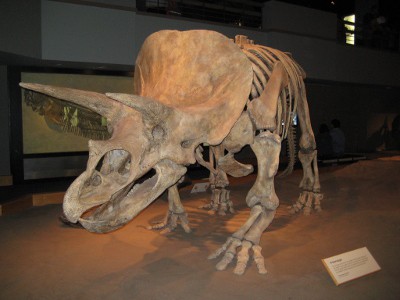University of Montana under pressure to value dinosaur bones for insurance purposes

 The University of Montana’s Museum of the Rockies has found itself struggling to comply with a recent audit, admitting that the stated market value of $64.5 million for its collection of artifacts, including thousands of dinosaur bones, has “always been more of a wild guess,” according to the museum’s financial director.
The University of Montana’s Museum of the Rockies has found itself struggling to comply with a recent audit, admitting that the stated market value of $64.5 million for its collection of artifacts, including thousands of dinosaur bones, has “always been more of a wild guess,” according to the museum’s financial director.
But Montana’s Legislative Audit division is requesting that the Museum of the Rockies figure out a value for its collection in order to comply with state insurance policy requirements.
Speaking to the Bozeman Daily Chronicle, financial director Jeff Krauss suggests that “they’re not worth anything,” seeing as the museum’s dinosaur bones were found on federal land, and so belong to the people.
The October report, prepared by Montana’s Legislative Audit division contains three recommendations directed at the university’s Museum of the Rockies, which has a collection contains 360,000 items, ranging from “vintage washing machines” to dinosaur knuckles.
“In January 2015, MSU–Bozeman reported to RMTD approximately $64.5 million as the market value for items in the MoR’s collections,” reads the audit. “Of this amount, $60 million was reported as the value for various exhibited and stored fine arts and collectibles, dinosaur artifacts and skeletons, paleontology holdings, and loaned items that are part of the MoR’s permanent collections. The university was not able to provide us with documentation supporting the $60 million estimated value of exhibited and stored items.”
According to the audit, a lack of firm documentation to calculate market value for priceless artifacts makes compliance with state insurance policy requirements impossible.
“If they’re stolen or destroyed, would we buy new ones? No, we would not, that would not be ethical,” said Krauss. “We would dig for new ones, probably. What’s the cost? There’s a bigger challenge than going on eBay. If the roof caved in and crushed the new dinosaur display, what would the cost be? It’s not as simple as a store’s inventory.”
“Without a reasonable basis for determining the value at which to insure museum collections, the university may be unable to support a claim,” says the audit.
In Canada, laws enacted in the 1970s specify that artifacts such as fossils belong to the Crown, making it difficult to move or sell dinosaur bones, which means that bones dug up just to the north of Montana in Alberta don’t trade in the same kind of markets as fossils dug up in the U.S. or Mongolia, for example, which thrive worldwide.
“The Royal Tyrrell Museum of Palaeontology collections are among the best in North America,” according to the Alberta Ministry of Culture’s 2014 consolidated financial statements. “Approximately 145,000 catalogued specimens document the early history of life on earth. The collections include fossils, geological samples, comparative zoology specimens, and an extensive dinosaur mold and cast collection, as well as palaeontological materials recovered in Alberta through Historic Resource Impact Assessments. The Royal Tyrrell Museum is also responsible for one palaeontological site in southern Alberta.”
The Royal Alberta Museum houses almost 2 million natural history specimens, 144,000 ethnological and historical artifacts, as well as “millions” of archaeological objects.
For institutions like the Museum of the Rockies, the fear is that by creating a set value for its inventory, treasure hunters and poachers will be encouraged to scour the landscape looking for, and quite likely damaging, fossils mainly for their market rather than scientific value.
Since the 1997 sale of Sue, a Tyrannosaurus rex dug up in South Dakota and sold at auction to Chicago’s Field Museum for $9.7 million, the market in dinosaur bones has been hot.
When asked to justify the astronomical value paid for Sue at the time, the Field Museum’s president and chief executive John McCarter said, “We did not have an iconic specimen, and we wanted one.”
Much like one-of-a-kind paintings, the market value for dinosaur bones becomes clear when the auction hammer drops.
Montana’s Legislative Audit division is encouraging the Museum of the Rockies to list and evaluate the worth of its collection using existing staff and a combination of curators and interns, something which Krauss suggests instead requires expert appraisal.
“During our review, the university provided us with communications between MSU–Bozeman Safety and Risk Management, MoR, and RMTD staff occurring in December 2012 and January 2013, related to the insurance values for MoR collections to be reported in January 2013,” says the audit. “In one of those communications, MoR staff indicated they did not believe it was ethical to assign values to collection items, and that the $60 million reported value for exhibited and stored items was estimated several years prior and was no longer accurate.”
The museum is also under-resourced, making it difficult if not impossible to provide “reasonable estimates of market value for insurance purposes” for their vast collection, as demanded by the audit.
“We’ll work on it, but there’s no real market value … that the museum industry as a whole would find legitimate,” said Krauss. “Buying and selling of collections is considered unethical by most museums.”
For scientists, putting a market value on bones and ancient artifacts opens a range of harmful effects, from competition led by amateur archaeologists and poachers to the possibility that the museum may try to sell off parts of its collection to satisfy short-term government revenue needs, as happened in Detroit when the city attempted to sell off a few of the masterpieces residing in the Detroit Institute of the Arts collection at the height of municipal bankruptcy proceedings.

Terry Dawes
Writer
